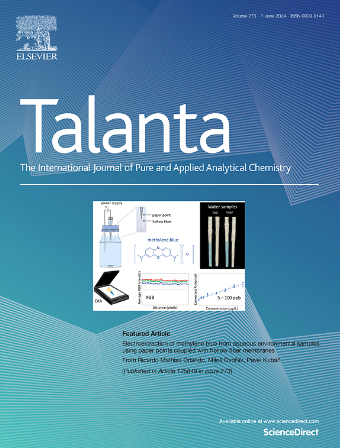Magnetic field facilitated-colorimetric aptasensor for selective and sensitive detection of Staphylococcus aureus using aptamer-labeled Zn/Co ICPs nanoenzyme
IF 5.6
1区 化学
Q1 CHEMISTRY, ANALYTICAL
引用次数: 0
Abstract
Colorimetric detection of pathogenic bacteria (such as S. aureus) in complex sample confronts challenges regarding sensitivity, selectivity, and accuracy. In this paper, a magnetic field facilitated (MFF)-colorimetric aptasensor was proposed for S. aureus detection based on magnetic separation and nanoenzyme-facilitated chromogenic reaction. The vancomycin-functionalized magnetic chitosan (CS-MNPs-Van) was introduced to capture and isolate S. aureus from the complex matrix through magnetic field separation. The zinc/cobalt infinite coordination polymers (Zn/Co ICPs) was rapidly prepared with a green synthesis technology at room temperature. It was directly functionalized with aptamer through interactions of Zn2+/Co2+ and phosphate backbone, large surface area and π-π stacking reactions, avoiding the tedious chemical modification. The aptamer-labeled Zn/Co ICPs (Zn/Co ICPs-Apt) exhibited not only the excellent peroxidase-like activity, but also the good specificity toward the captured S. aureus to generate CS-MNPs-Van@S. aureus@Zn/Co ICPs-Apt complexes. The residual unreacted Zn/Co ICPs-Apt catalyzed the oxidation of 3,3′,5,5′-tetramethylbenzidine (TMB) to produce blue oxTMB, which can be distinguished with naked eyes. The S. aureus concentration showed a negative correlation with the absorbance (A652 nm) in the range of 1.8 × 101 to 1.8 × 10⁵ CFU/mL, with a detection limit of 4 CFU/mL. The MFF-colorimetric aptasensor presents advantages of high sensitivity, good selectivity, low matrix interference and naked visualization without complicated devices, making it competitive candidate for on-site and large-scale detection of pathogens.
求助全文
约1分钟内获得全文
求助全文
来源期刊

Talanta
化学-分析化学
CiteScore
12.30
自引率
4.90%
发文量
861
审稿时长
29 days
期刊介绍:
Talanta provides a forum for the publication of original research papers, short communications, and critical reviews in all branches of pure and applied analytical chemistry. Papers are evaluated based on established guidelines, including the fundamental nature of the study, scientific novelty, substantial improvement or advantage over existing technology or methods, and demonstrated analytical applicability. Original research papers on fundamental studies, and on novel sensor and instrumentation developments, are encouraged. Novel or improved applications in areas such as clinical and biological chemistry, environmental analysis, geochemistry, materials science and engineering, and analytical platforms for omics development are welcome.
Analytical performance of methods should be determined, including interference and matrix effects, and methods should be validated by comparison with a standard method, or analysis of a certified reference material. Simple spiking recoveries may not be sufficient. The developed method should especially comprise information on selectivity, sensitivity, detection limits, accuracy, and reliability. However, applying official validation or robustness studies to a routine method or technique does not necessarily constitute novelty. Proper statistical treatment of the data should be provided. Relevant literature should be cited, including related publications by the authors, and authors should discuss how their proposed methodology compares with previously reported methods.
 求助内容:
求助内容: 应助结果提醒方式:
应助结果提醒方式:


